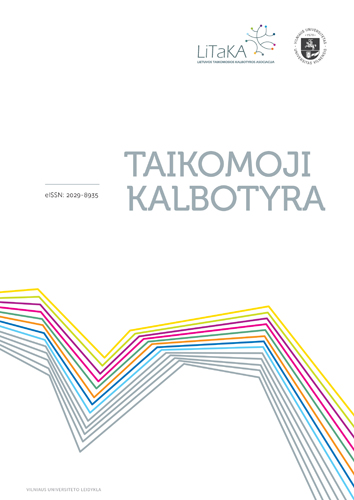Antrosios kalbos įsisavinimas natūralioje aplinkoje: įvaikinimo Italijoje atvejis
Naturalistic second language acquisition: a case of adoption in Italy
Author(s): Jogilė Teresa RamonaitėSubject(s): Language acquisition, Psycholinguistics, Family and social welfare
Published by: Vilniaus Universiteto Leidykla
Keywords: second language acquisition; spontaneous L2 acquisition; international adoption; language development of adopted children; language learner varieties; development of predicate expression;
Summary/Abstract: The functional approach to the interlanguage of spontaneous learners of L2 permits to see that from the very beginning when not yet possessing many resources of the target language the speakers makes a systemic use of them. When acquiring a language in a naturalistic environment the effectiveness of the communication is of vital importance to the speaker because he or she must start interacting without yet having acquired many of the elements of the structure of the target language. A second language learner makes use of the cognitive resources already in possession and therefore when beginning to use the new language invokes the universal pragmatic principles for utterance organization such as word order and similar. A very important step in L2 acquisition is the appearance of the predicate in the interlanguage of the learner because then the utterances of the speaker start to be constructed following also the semantic-syntactic principles. This variety of the learnerʼs interlanguage, called the basic variety, is essentially sufficient for the elementary communication and the development of the interlanguage in the morphological perspective fossilizes in this variety for some learners. In time and given favourable conditions, the interlanguage of the learner can move on to a so-called post-basic variety, that sees the formation of a system approaching that of the target language and the principles of utterance organization previously used are gradually replaced by syntactic principles characteristic to the specific target language. The situation of international adoption creates conditions that are very favourable for language acquisition also to the older children. The article presents examples and analysis of the linguistic behaviour of an over 11-year-old Lithuanian girl adopted to Italy. Her linguistic behaviour has been meticulously observed and recorded for a year after the adoption starting from the very first contact with the new language. The analysis shows that the structure of the target language is acquired in a universal path: from simple forms to more complex ones, however the situation in which the acquisition takes place determines the great rapidity of acquisition and a very advanced level after a year in the new country. The observed girl reaches the basic variety after having spent only a month surrounded by the new language and one month later her interlanguage presents clear signs that indicate morphological sensitivity and the interlanguage system that is heading towards that of the target language. After a year in the country the entire Italian verb system is in place, including the most complex parts of it, moreover, the girl fluently makes use of those system elements that are not obligatory, but optional, in a way that native speakers are able to do.
Journal: Taikomoji kalbotyra
- Issue Year: 2013
- Issue No: 2
- Page Range: 1-30
- Page Count: 30
- Language: Lithuanian

